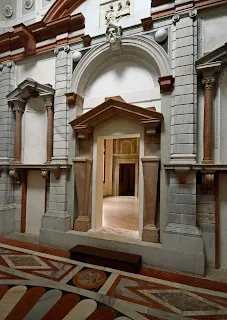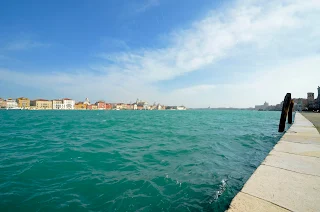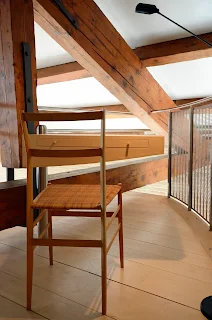I arrived in Berlin on Friday evening and went straight to my hotel on Kurfurstendamm, which seems to be the strassa to shop.
It was 15 minutes from the Tegel airport to the hotel, easiest airport access I ever experienced.
It was 15 minutes from the Tegel airport to the hotel, easiest airport access I ever experienced.
In the morning I hopped on a bus to get to the Reichstag, Norman Foster's great renovation of the German capitol. On the way the bus stopped at the Tiergarten, and I got out at the Zoo. As I followed the paths in the Tiergarten, I got to the Aquarium, and I realized that the Dolphins were not playing, the first sign of bad omens. When I got to the Reichstag, the number one thing to see in Berlin, I was told that I would need a reservation 7 days in advance...security rears it foolish head.
The Brandenburg Gate
So, no Dolphins, no Sir Norman, we still have Schinkel. Karl Fredrick Schinkel helped reorganize Berlin in the early 19th century with his planning and great buildings. As I passed through the Brandenburg Gate to what was East Berlin, new buildings abound.
Looking back, the sense of the new city seems alive.
This is the first antica building I see, Schinkel's neoclassical Neue Wache, a chapel which was repurposed as a
Memorial to Victims of Militarism and Tyranny.
The interior is empty save for the light and the sculpture of a mother with her dead child in bronze.
Altes Museum
Altes Museum
Just over the bridge is the Lustgarten with the Altes Museum facing onto it. The other museums, on the museum island are behind the Altes. Schinkel imagined this museum island and set his grande neoclassical museum on the central axis facing his enormous Public Garden.
As one enters the museum, the greatness of Greece and Rome express themselves above.
And on either side the portico runs across the facade, the marble rosso is faux, it was restored 30 years ago, after the paint had long vanished.
The Altes contains many of the items found in the earliest excavations of Greek civilization by the Germans in the early 19th century. These amphora are ideal images of the palaestra:
These Amphora are beautiful examples of the Greek craftsman's virtu.
Behind the Altes Museum are 4 other museums in a Park enclosed by an elegant colonade.
With a bronze Diana among many garden sculptures...
The Pergamon Museum contains the Pergamon Alter and other great finds from Archeological digs in the 19th Century. The scale of the Pergamon Alter above is domestic, an important detail not visible from text book photos.
This blue glazed tile wall is one part of a large palace from Babylon, it is amazing the craftsmanship and knowledge which went into this building, now in Berlin. Good thing the Germans got it before Rumsfeld got his operation going.
And from the Nueumuseum, destroyed in WWII, and rebuilt, a goddess:
I need to mention that this museum of Egyptology has a room devoted to the bust of Nefertiti, no photos allowed. This sculpture, in real life, is so much more powerful than any of its photographs, probably the most beautiful sculpture to come from Egypt.
I left after Blitzing these 5 museums to see something modern and went to the Kulturforum, home to the Philharmonic Hall, the Neue Museum and one or two others. Hans Scharoun's Philharmonia from 1962 is a wonder, its orchestra in the round approach allows the German romantic music to reverberate through the house. No concerts this week.
The exterior, clad in a golden aluminum, leaves something to be desired. Today,techi materials are more abundant and he would have made a better choice, though a red brick would not be a poor choice as the main element.....Here we view it from the interior of
Mies's NueuNationalGallery.
The National Gallery has modernist art from the 20th Century, mostly German, all housed in the basement, which opens on to a sunken garden. The main floor, which we all know from photographs, houses coat closets, ticketing areas and an occasional spectacle...
Here is some sort of sound influenced colored shapes projected on the interior of a white nylon cube.
They at least could have a caffe here, allowing the public to enjoy the space, such as it is, without chaos.
Here is Mies's big idea, the disappearing corner. Thinking Vitruvius long dead, he never thought he might be judged on something as banal as Utiliti, such as, the ability to hang and judge art...
This evening is the night of the huge moon, and when I got back to Venezia, it was over the basino di San Marco...
...welcoming me back home.
The stairway is designed as external, open to the weather, museums at thebeginning, may have been thought of as a seasonal divertment. The renovation enclosed the stairhall with glass butted to the flutes of the greek columns of the interior, sensitive, and invisible from the exterior.
It should not have to be noted that these were the ideals of the enlightenment and were carried west by settlers in the new frontier on the United States, naming their towns after Greek places and myths. Athens, Apollo, Minveva, Arcadia, Aurora, Clio, Corith, Diana, Fortuna, Delphi, Oracle, Hector, Parthenon, Elysian, Marathon, Olympia, Neptune, Paris, Sparta, Troy, Vesta, and many more town names populate our states.
These Amphora are beautiful examples of the Greek craftsman's virtu.
Behind the Altes Museum are 4 other museums in a Park enclosed by an elegant colonade.
With a bronze Diana among many garden sculptures...
This blue glazed tile wall is one part of a large palace from Babylon, it is amazing the craftsmanship and knowledge which went into this building, now in Berlin. Good thing the Germans got it before Rumsfeld got his operation going.
And from the Nueumuseum, destroyed in WWII, and rebuilt, a goddess:
I need to mention that this museum of Egyptology has a room devoted to the bust of Nefertiti, no photos allowed. This sculpture, in real life, is so much more powerful than any of its photographs, probably the most beautiful sculpture to come from Egypt.
I left after Blitzing these 5 museums to see something modern and went to the Kulturforum, home to the Philharmonic Hall, the Neue Museum and one or two others. Hans Scharoun's Philharmonia from 1962 is a wonder, its orchestra in the round approach allows the German romantic music to reverberate through the house. No concerts this week.
The exterior, clad in a golden aluminum, leaves something to be desired. Today,techi materials are more abundant and he would have made a better choice, though a red brick would not be a poor choice as the main element.....Here we view it from the interior of
Mies's NueuNationalGallery.
The National Gallery has modernist art from the 20th Century, mostly German, all housed in the basement, which opens on to a sunken garden. The main floor, which we all know from photographs, houses coat closets, ticketing areas and an occasional spectacle...
Here is some sort of sound influenced colored shapes projected on the interior of a white nylon cube.
They at least could have a caffe here, allowing the public to enjoy the space, such as it is, without chaos.
Here is Mies's big idea, the disappearing corner. Thinking Vitruvius long dead, he never thought he might be judged on something as banal as Utiliti, such as, the ability to hang and judge art...
This evening is the night of the huge moon, and when I got back to Venezia, it was over the basino di San Marco...
...welcoming me back home.





























































